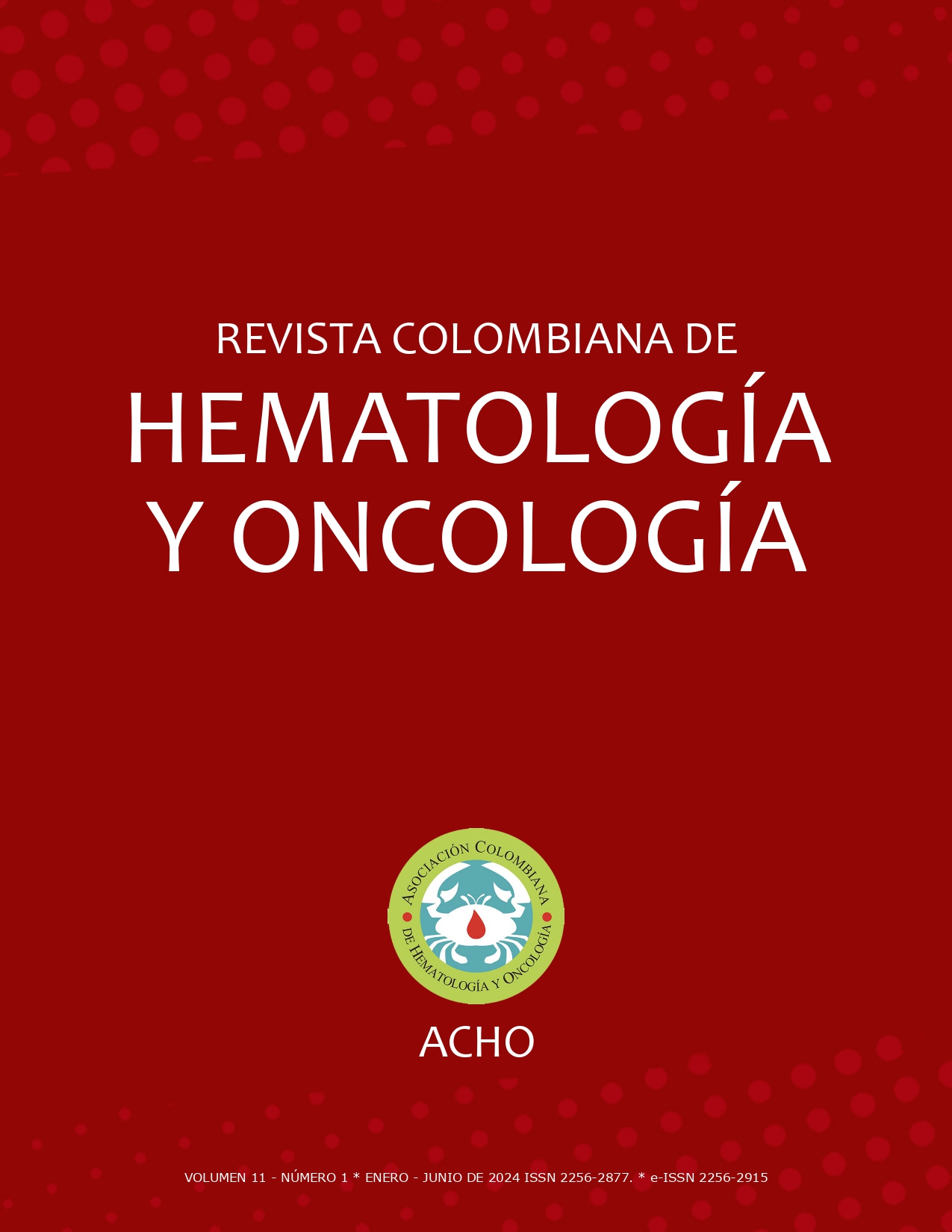Antitumor activity of copper(II) complexes with phenanthroline and dipeptides in cultured breast cancer cells
Actividad antitumoral de complejos de cobre(II) con fenantrolina y dipéptidos en células de cáncer de mama

How to Cite
Download Citation

This work is licensed under a Creative Commons Attribution-NonCommercial-NoDerivatives 4.0 International License.
Show authors biography
The search for non-toxic anti-cancer therapies has increased, allowing the development of new metal complexes linked to essential molecules such as amino acids. For this reason, two copper(II) compounds were studied with a main ligand such as 1,10 phenanthroline (phen). The complex [CuCl2(phen)] (1) was studied in comparison to the ternary complex with a dipeptide (the result of the union of two amino acids such as alanine and phenylalanine as an auxiliary ligand) [Cu(L-Ala-Phe) (phen)]·4 H2O (2) in the human breast cancer cell line MCF-7. Functional analysis showed that both complexes induce antiproliferative and an effect on clone inhibition; Anyway, neither of the two complexes showed an increase in the production of EROs. On the other hand, the phenomenon of cell death induced by 1 occurs through the necrosis process, while 2 causes the induction of early apoptosis. Likewise, only at low concentrations of 2 (1 μM), we found double and single-strand DNA breaks, which suggests that it could be one of the molecular targets related to its antitumor activity. This compound is a promising candidate for further in vivo studies that prove to be a good alternative therapy for breast cancer.
Article visits 617 | PDF visits 351
Downloads
- Global Cancer Statistics 2020: Cancer fact sheets -Estimates of Incidence and Mortality Argentina. GLOBOCAN [Internet]. 2021[citado 05 de mayo de 2023];1-2. Disponible en: https://gco.iarc.fr/today/data/factsheets/populations/32-argentina-fact-sheets.pdf
- Global Cancer Statistics 2020: Cancer fact sheets -Estimates of Incidence and Mortality Colombia. GLOBOCAN [Internet]. 2021[citado 05 de mayo de 2023];1-2. Disponible en: https://gco.iarc.fr/today/data/factsheets/populations/170-colombia-fact-sheets.pdf.
- Lucaciu RL, Hangan AC, Sevastre B, Oprean LS. Metallo-Drugs in Cancer Therapy: Past, Present and Future. Molecules [Internet]. 2022; 27(19):6485. Disponible en: https://doi.org/10.3390/molecules27196485
- Zhang Z, Wang H, Yan M, Wang H, Zhang C. Novel copper complexes as potential proteasome inhibitors for cancer treatment (Review). Mol Med Rep [Internet]. 2017 Jan 1;15(1):3–11. Disponible en: https://doi.org/10.3892/mmr.2016.6022.
- Laws K, Bineva-Todd G, Eskandari A, Lu C, O'Reilly N, Suntharalingam K. A Copper (II) Phenanthroline Metallopeptide That Targets and Disrupts Mitochondrial Function in Breast Cancer Stem Cells. Angew Chem Int Ed Engl [Internet]. 2018 Jan 2;57(1):287-291. Disponible en: https://doi.org/10.1002/anie.201710910.
- Anthony EJ, Bolitho EM, Bridgewater HE, Carter OWL, Donnelly JM, Imberti C, Lant EC, Lermyte F, Needham RJ, Palau M, Sadler PJ, Shi H, Wang FX, Zhang WY, Zhang Z. Metallodrugs are unique: opportunities and challenges of discovery and development. Chem Sci [Internet]. 2020 Nov 12;11(48):12888-12917. Disponible en: https://doi.org/10.1039/d0sc04082g.
- De Luca A, Barile A, Arciello M, Rossi L. Copper homeostasis as target of both consolidated and innovative strategies of anti-tumor therapy. J Trace Elem Med Biol [Internet]. 2019 Sep;55:204-213. Disponible en: https://doi.org/10.1016/j.jtemb.2019.06.008.
- Blockhuys S, Wittung-Stafshede P. Roles of Copper-Binding Proteins in Breast Cancer. Int J Mol Sci [Internet]. 2017 Apr 20;18(4):871. Disponible en: https://doi.org/10.3390/ijms18040871
- Denoyer D, Masaldan S, La Fontaine S, Cater MA. Targeting copper in cancer therapy: 'Copper That Cancer'. Metallomics [Internet]. 2015 Nov;7(11):1459-76. Disponible en: https://doi.org/10.1039/c5mt00149h.
- Efremov Ivanov M. Síntesis de fenantrolinas funcionalizadas y complejos de cobre(I). [dissertation]. [España]: Universidad de Valladolid. 2021.51.
- Mc Givern TJP. Multi-functional Copper(II) Drug Candidates as Potential Anti-Cancer Agents [PhD Thesis]. [Dublin]; Royal College of Surgeons in Ireland; 2016.
- Prihantono, Irfandi R, Raya I, Warsinggih. Potential anticancer activity of Mn (II) complexes containing arginine dithiocarbamate ligand on MCF-7 breast cancer cell lines. Ann Med Surg (Lond) [Internet]. 2020 Nov 11;60:396-402. Disponible en: https://doi.org/10.1016/j.amsu.2020.11.018.
- Iglesias S, Alvarez N, Torre MH, Kremer E, Ellena J, Ribeiro RR, Barroso RP, Costa-Filho AJ, Kramer MG, Facchin G. Synthesis, structural characterization and cytotoxic activity of ternary copper(II)-dipeptide-phenanthroline complexes. A step towards the development of new copper compounds for the treatment of cancer. J Inorg Biochem [Internet]. 2014 Oct;139:117-23. Disponible en: https://doi.org/10.1016/j.jinorgbio.2014.06.007.
- Mosmann T. Rapid colorimetric assay for cellular growth and survival: application to proliferation and cytotoxicity assays. J Immunol Methods [Internet]. 1983 Dec 16;65(1-2):55-63. Disponible en: https://doi.org/10.1016/0022-1759(83)90303-4.
- Fernández-Blanco C. Estudos in vitro de los mecanismos de toxicidad de las micotoxinas. [dissertation] [Valencia (PA)]: Universidad de Valencia; 2017. 416.
- Martínez-Pastor F, Mata-Campuzano M, Alvarez-Rodríguez M, Alvarez M, Anel L, de Paz P. Probes and techniques for sperm evaluation by flow cytometry. Reprod Domest Anim [Internet]. 2010 Jun;45 Suppl 2:67-78. Disponible en: https://doi.org/10.1111/j.1439-0531.2010.01622.x.
- Smith PK, Krohn RI, Hermanson GT, Mallia AK, Gartner FH, Provenzano MD, Fujimoto EK, Goeke NM, Olson BJ, Klenk DC. Measurement of protein using bicinchoninic acid. Anal Biochem [Internet]. 1985 Oct;150(1):76-85. Disponible en: https://doi.org/10.1016/0003-2697(85)90442-7. Erratum in: Anal Biochem 1987 May 15;163(1):279.
- Singh NP, McCoy MT, Tice RR, Schneider EL. A simple technique for quantitation of low levels of DNA damage in individual cells. Exp Cell Res [Internet]. 1988 Mar;175(1):184-91. Disponible en: https://doi.org/10.1016/0014-4827(88)90265-0.
- Li DD, Yagüe E, Wang LY, Dai LL, Yang ZB, Zhi S, Zhang N, Zhao XM, Hu YH. Novel Copper Complexes That Inhibit the Proteasome and Trigger Apoptosis in Triple-Negative Breast Cancer Cells. ACS Med Chem Lett [Internet]. 2019 Jul 25;10(9):1328-1335. Disponible en: https://doi.org/10.1021/acsmedchemlett.9b00284.
- Thornton L, Dixit V, Assad LO, Ribeiro TP, Queiroz DD, Kellett A, Casey A, Colleran J, Pereira MD, Rochford G, McCann M, O'Shea D, Dempsey R, McClean S, Kia AF, Walsh M, Creaven B, Howe O, Devereux M. Water-soluble and photo-stable silver(I) dicarboxylate complexes containing 1,10-phenanthroline ligands: Antimicrobial and anticancer chemotherapeutic potential, DNA interactions and antioxidant activity. J Inorg Biochem [Internet]. 2016 Jun;159:120-32. Disponible en https://doi.org/10.1016/j.jinorgbio.
- Hassan M, Watari H, AbuAlmaaty A, Ohba Y, Sakuragi N. Apoptosis and molecular targeting therapy in cancer. Biomed Res Int [Internet]. 2014;2014:150845. Disponible en: https://doi.org/10.1155/2014/150845. Epub 2014 Jun 12. Retraction in: Biomed Res Int [Internet]. 2020 Aug 28;2020:2451249.
- Cadavid Vargas JF. Screening de metalofármacos derivados de N-heterociclos y metales de transición en cultivos celulares 2D y 3D según sus efectos antitumorales. [PhD Thesis]. [Argentina]; Universidad de la Plata. 2019
- Balsa LM, Ruiz MC, Santa Maria de la Parra L, Baran EJ, León IE. Anticancer and antimetastatic activity of copper (II)-tropolone complex against human breast cancer cells, breast multicellular spheroids and mammospheres. J Inorg Biochem [Internet]. 2020 Mar; 204:110975. Disponible en: https://doi.org/10.1016/j.jinorgbio.2019.110975.
- Waks AG, Winer EP. Breast Cancer Treatment: A Review. JAMA [Internet]. 2019 Jan 22;321(3):288-300. Disponible en: https://doi.org/10.1001/jama.2018.19323.
- Ding C, Tong L, Feng J, Fu J. Recent Advances in Stimuli-Responsive Release Function Drug Delivery Systems for Tumor Treatment. Molecules [Internet]. 2016 Dec 20;21(12):1715. Disponible en: https://doi.org/10.3390/molecules21121715.
- Boulsourani Z, Katsamakas S, Geromichalos GD, Psycharis V, Raptopoulou CP, Hadjipavlou-Litina D, Yiannaki E, Dendrinou-Samara C. Synthesis, structure elucidation and biological evaluation of triple bridged dinuclear copper(II) complexes as anticancer and antioxidant/anti-inflammatory agents. Mater Sci Eng C Mater Biol Appl [Internet]. 2017 Jul 1;76:1026-1040. Disponible en: doi: https://doi.org/10.1016/j.msec.2017.03.157.
- Oliveri V, Lanza V, Milardi D, Viale M, Maric I, Sgarlata C, Vecchio G. Amino- and chloro-8-hydroxyquinolines and their copper complexes as proteasome inhibitors and antiproliferative agents. Metallomics [Internet]. 2017 Oct 18;9(10):1439-1446. Disponible en: https://doi.org/10.1039/c7mt00156h.
- Esteban León I, Fernando Cadavid-Vargas J, Laura Di Virgilio A, Beatriz Etcheverry S. Vanadium, Ruthenium and Copper Compounds: A New Class of Non-platinum Metallodrugs with Anticancer Activity. Curr Med Chem [Internet]. 2016;23:1–37. Disponible en: https://doi.org/10.2174/0929867323666160824162546
- Heinrich J, Bossak-Ahmad K, Riisom M, Haeri HH, Steel TR, Hergl V, Langhans A, Schattschneider C, Barrera J, Jamieson SMF, Stein M, Hinderberger D, Hartinger CG, Bal W, Kulak N. Incorporation of β-Alanine in Cu(II) ATCUN Peptide Complexes Increases ROS Levels, DNA Cleavage and Antiproliferative Activity. Chemistry [Internet]. 2021 Dec 23;27(72):18093-18102. Disponible en: https://doi.org/10.1002/chem.202102601.
- Maugeri S, Sibbitts J, Privitera A, Cardaci V, Di Pietro L, Leggio L, Iraci N, Lunte SM, Caruso G. The Anti-Cancer Activity of the Naturally Occurring Dipeptide Carnosine: Potential for Breast Cancer. Cells [Internet]. 2023 Nov 8;12(22):2592. Disponible en https://doi.org/10.3390/cells12222592.
- H. F, Zarghi A, Kobarfard F, Zendehdel R, Nakhjavani M, Arfaiee S, et al. Remarks in Successful Cellular Investigations for Fighting Breast Cancer Using Novel Synthetic Compounds. Breast Cancer - Focusing Tumor Microenvironment, Stem cells and Metastasis. InTech [Internet]; 2011. Disponible en: http://dx.doi.org/10.5772/23005
- Zhang Z, Bi C, Schmitt SM, Fan Y, Dong L, Zuo J, Dou QP. 1,10-Phenanthroline promotes copper complexes into tumor cells and induces apoptosis by inhibiting the proteasome activity. J Biol Inorg Chem [Internet]. 2012 Dec;17(8):1257-67. Disponible en: https://doi.org/10.1007/s00775-012-0940-x.
- Gałczyńska K, Drulis-Kawa Z, Arabski M. Antitumor Activity of Pt(II), Ru(III) and Cu(II) Complexes. Molecules [Internet]. 2020 Jul 31;25(15):3492. Disponible en https://doi.org/10.3390/molecules25153492
- Sigman DS, Graham DR, D'Aurora V, Stern AM. Oxygen-dependent cleavage of DNA by the 1,10-phenanthroline. cuprous complex. Inhibition of Escherichia coli DNA polymerase I. J Biol Chem [Internet]. 1979 Dec 25;254(24):12269-72. Disponible en: https://www.jbc.org/article/S0021-9258(19)86305-6/pdf
- Cadavid-Vargas JF, Villa-Pérez C, Ruiz MC, León IE, Valencia-Uribe GC, Soria DB, Etcheverry SB, Di Virgilio AL. 6-Methoxyquinoline complexes as lung carcinoma agents: induction of oxidative damage on A549 monolayer and multicellular spheroid model. J Biol Inorg Chem [Internet]. 2019 Mar;24(2):271-285. Disponible en: https://doi.org/10.1007/s00775-019-01644-7.
- Chikira M, Ng CH, Palaniandavar M. Interaction of DNA with Simple and Mixed Ligand Copper(II) Complexes of 1,10-Phenanthrolines as Studied by DNA-Fiber EPR Spectroscopy. Int J Mol Sci [Internet]. 2015 Sep 21;16(9):22754-80. Disponible en: https://doi.org/10.3390/ijms160922754.
- Gong Y, Fan Z, Luo G, Yang C, Huang Q, Fan K, Cheng H, Jin K, Ni Q, Yu X, Liu C. The role of necroptosis in cancer biology and therapy. Mol Cancer [Internet]. 2019 May 23;18(1):100. Disponible en: https://doi.org/10.1186/s12943-019-1029-8
- Tong X, Tang R, Xiao M, Xu J, Wang W, Zhang B, Liu J, Yu X, Shi S. Targeting cell death pathways for cancer therapy: recent developments in necroptosis, pyroptosis, ferroptosis, and cuproptosis research. J Hematol Oncol [Internet]. 2022 Dec 8;15(1):174. Disponible en: https://doi.org/10.1186/s13045-022-01392-3.
- Ortega-Forte E, Hernández-García S, Vigueras G, Henarejos-Escudero P, Cutillas N, Ruiz J, Gandía-Herrero F. Potent anticancer activity of a novel iridium metallodrug via oncosis. Cell Mol Life Sci [Internet]. 2022 Sep 6;79(10):510. Disponible en: https://doi.org/10.1007/s00018-022-04526-5.
- de Sousa IH, Campos VNS, Vale AAM, Maciel-Silva VL, Leite CM, Lopes AJO, Mourão PS, das Chagas Alves Lima F, Batista AA, de Azevedo Dos Santos APS, Almeida MAP, Pereira SRF. Ruthenium (II) complexes with N, O-chelating proline and threonine ligands cause selective cytotoxicity by the induction of genomic instability, cell cycle arrest and apoptosis in breast and prostate tumor cells. Toxicol In Vitro [Internet]. 2020 Feb;62:104679. Disponible en: https://doi.org/10.1016/j.tiv.2019.104679.
- Lima AP, Pereira FC, Almeida MA, Mello FM, Pires WC, Pinto TM, Delella FK, Felisbino SL, Moreno V, Batista AA, de Paula Silveira-Lacerda E. Cytoxicity and apoptotic mechanism of ruthenium(II) amino acid complexes in sarcoma-180 tumor cells. PLoS One [Internet]. 2014 Oct 17;9(10):e105865. Disponible en: https://doi.org/10.1371/journal.pone.0105865.
- Wang Q, Holst J. L-type amino acid transport and cancer: targeting the mTORC1 pathway to inhibit neoplasia. Am J Cancer Res [Internet]. 2015; 15. Disponible en: https://www.ncbi.nlm.nih.gov/pmc/articles/PMC4473310/pdf/ajcr0005-1281.pdf
- Shennan DB, Thomson J, Gow IF, Travers MT, Barber MC. L-leucine transport in human breast cancer cells (MCF-7 and MDA-MB-231): kinetics, regulation by estrogen and molecular identity of the transporter. Biochim Biophys Acta [Internet]. 2004 Aug 30;1664(2):206-16. Disponible en: https://doi.org/10.1016/j.bbamem.2004.05.008.
- Liu Y, Zhao T, Li Z, Wang L, Yuan S, Sun L. The role of ASCT2 in cancer: A review. Eur J Pharmacol [Internet]. 2018 Oct 15;837:81-87. Disponible en: https://doi.org/10.1016/j.ejphar.2018.07.007.

















